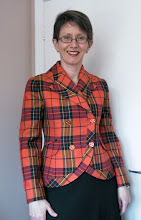Step one: pin out the extra fabric.
It's an awful lot. When I undid the pinning (having replaced the pins to outline what had been pinned out) this is what I was confronted with.
 It's roughly 2cm of length below the back waist, and 2.5cm at the widest point of each under-seat fisheye dart.
It's roughly 2cm of length below the back waist, and 2.5cm at the widest point of each under-seat fisheye dart.
Step two: draw that on the pattern piece (at right). Hmm ... that was strangely easy. But now what?
Step three: think. How the heck do I get those adjustments to the outer edge? Photo at left was an effort to see if I could use the technique that Kenneth King wrote about in issue 102 of Threads Magazine. Basically, you measure the pinned out dart at each line and then take that amount out at the other end of the line you have drawn perpendicular to the CL of the dart. The result here (red lines show the adjusted seam lines) didn't fill me with confidence, since it would have the effect of taking horizontal width out of the CB which I am pretty sure wasn't part of my problem.
Step four: research. Good old Google. I plugged in the term "flat seat adjustment" and up popped (among many other sites) the brilliant Flickr tutorial authored by the brilliant Ann Rowley.
All of my faithful readers will no doubt recognize this elegant lady, the winner of the first go-round of the Great British Sewing Bee. She is a talented knitter as well as a fabulous seamstress. Her photo exposé on the making of Vogue 8804 (the Chanel-ish jacket, my version of which is languishing for a second summer in a UFO closet of shame) beautifully illustrates all 94 (94!!) steps from the pattern instructions. I bow down to Ann Rowley, truly.
But I digress. Her flat seat adjustment instructions are oh-so-simple and, miracle of miracles, they end up producing precisely the result I am pretty sure I need.
 |
| Cutting lines |
Step five: Slice, dice and adjust. Mark one cutting at right angles to the straight of grain, through the crotch point; one running up through the waist, parallel to the grain; and one at an angle intersecting with the crotch curve.
 |
| Adjusted pattern |
The result is at right. Black marks the cutting lines, green shows how much they are overlapped. Blue shows the original pattern piece outlines and red shows the adjusted piece. As you can see, the crotch curve is lower and the CB seam is more vertical (less darted). The back waist is lower and the side seam more curved.
I followed Ann Rowley's instructions to the letter, including the amounts she said to adjust. This had no automatic relationship with my particular figure, but it so happens that the distance between the more or less horizontal green and black lines (the fisheye dart in action) is 2.5cm, which is exactly what I needed to remove as per my pinned out darts. The adjustment also narrows the back waist somewhat, which I needed to do anyway, so I will not add this back at the side seams.
The question remains whether I need to take more length out at CB. I will try sewing this pattern as adjusted to this point, having taken Ann Rowley's words of wisdom to heart:
"The suggested size of the diagonal overlap may be adjusted but even so you're unlikely to get a totally flat smooth seat. Do remember that you need to bend, stretch and most importantly, sit down! Don't be tempted to over fit ."
Stay tuned.






Your photo essay though shorter is at Ann standard! I have the opposite issue to a flat seat, but this is helpful - i'm going to try making the same cuts and opening them. Looking forward to seeing your next barbs!
ReplyDeleteBrilliant. Thanks for the link to Ann's instructions. A new way to think about adjustments.
ReplyDeleteRe her quote about not being tempted to overfit – I once saw a woman wearing the most perfectly fitted trousers (pre stretch-fabrics) – so inspiring that if I could achieve the same perfection in fitting, I would.
Vancouver Barbara
Wonderful, clear tutorial. Thanks so much! Only wish I had a flat seat!
ReplyDeleteThanks for the reminder of Ann's tutorial. Just a thought though, you may want to "over fit" if you are using a stretch fabric, cos thats the point really. Anyway, looking forward to seeing how this turns out. I want to order a Stylearc pattern for some slim stretch pants/leggings and I am pretty sure I will have the same issue as you.
ReplyDeleteThank goodness for my non-flat seat. I am totally at a loss already. Good for your analytical mind!
ReplyDeleteAnd, depending on your fabric it will stretch out and that perfectly hanging rear end will be baggy again. Not quite like the original, but it will bag out. I've used Ann's method, but I think that KK's method gets you the same results. The perfectly fitted rear is just not possible with a very flat seat.
ReplyDeleteStyleArc has a tutorial on their website which described a similar approach. It also talked about establishing a grainline which was helpful.
ReplyDeleteWhy, so it does! http://www.stylearc.com.au/stylearc/index.php?option=com_content&view=article&id=56&Itemid=69
DeleteI use Ann's brilliant Flat Seat alteration too, but I found that I needed to do it twice to get the desired effect. (Yes, really, really flat seat here.) I don't think I'd have gotten quite the same results by doing it once, twice as much. I never went back and tried though. And as I recall, Ann addresses the grainline issue as well. Maybe not what you're talking about though, haven't compared StyleArc's method.
ReplyDeleteThank you for showing! Maybe that was my salvation!
ReplyDeleteThank you!
ReplyDeleteThis is interesting! Where can I see the end result?
ReplyDeleteHi there. Thanks so much for sharing this with us. Leaving for 5 months but I know I will be tweeting my pant pattern when I come back.
ReplyDeleteÈ una correzione per glutei alti e non piatti
ReplyDelete